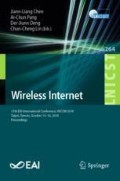Abstract
Medical services influence the people’s health and lives. It is a sacred and professional work with the features that do not allow errors and cannot be redone. Therefore, the quality of medical services directly affects the health and safety of patients. In the operating room, the central supply room is responsible for sterilizing surgical instruments. It is also an important place for infection control. Once incompletely sterilized medical devices are used, it may lead to nosocomial infections, thus affecting the safety and quality of the surgical patients. Therefore, to ensure the integrity of the sterilization process and to avoid the use of unsafe surgical instruments. This study uses the sensing technology of the Internet of Things to monitor the sterilization process of surgical instruments sterilization with using the automatic monitoring system to alarm the validity period of surgical instruments pack, and to calculate the required safety stock of surgical instruments packing. With the system, it reduces the additional cost of emergency sterilization when surgical instruments packs are out of supply. Ensure the safety of the patient’s use of surgical instruments, so that patients can be treated in a safer medical environment to achieve a win-win benefit.
Access this chapter
Tax calculation will be finalised at checkout
Purchases are for personal use only
References
Wilson, R.M., Harrison, B.T., Gibberd, R.W., Hamilton, J.A.: An analysis of the causes of adverse events from the quality in australian health care study. Medi. J. Aust. 170(9), 411–415 (1999)
Cuschieri, A.: Nature of human error: implications for surgical practice. Ann. Surg. 244(5), 642–648 (2006)
de Vries, E.N., Ramrattan, M.A., Smorenburg, S.M., Gouma, D.J., Boermeester, M.A.: The incidence and nature of in-hospital adverse events: a systematic review. Qual. Saf. Health Care 17(3), 216–223 (2008)
Arora, S., Hull, L., Sevdalis, N., Nestel, D., Woloshynowych, M., et al.: Factors compromising safety in surgery: stressful events in the operating room. Am. J. Surg. 199(1), 60–65 (2010)
Gawande, A.A., Zinner, M., Studdert, D., Brennan, T.A.: Analysis of errors reported by surgeons at three teaching hospitals. Surgery 133(6), 614–621 (2003)
WHO News: Safe surgery saves lives: the second global patient safety challenge. Int. J. Risk Saf. Med. 20(3), 181–182 (2008)
The Joint Commission of Taiwan. Annual target and strategy for hospital patient safety in 107 and 108 (2017). http://www.jct.org.tw/FrontStage/index.aspx
Rosales, C.R., Magazine, M., Rao, U.: The 2Bin system for controlling medical supplies at point-of-use. Eur. J. Oper. Res. 243(1), 271–280 (2015)
Chang, Y.-Y., Chang, S.-C., Chen, Y.-C., Huang, P.-H.: Taiwan sterilization monitoring measures guide. J. Infect. Control 15(1), 27–44 (2005)
Acosta-Go, E., Mata-Portuguez, V.H., Herrero-Faras, A., Sanchez, L.: Biologic monitoring of dental office sterilizers in mexico. Am. J. Infect. Control 30(3), 153–157 (2002)
Kelkar, U., Bal, A.M., Kulkarni, S.: Monitoring of steam steril ization process by biologic indicatorsa necessary surveillance tool. Am. J. Infect. Control 32(8), 512–513 (2004)
Rutala, W.A., Weber, D.J.: Disinfection and sterilization in health care facilities: an overview and current issues. Infect. Dis. Clin. North Am. 30(3), 609–637 (2016)
Spry, C.: Understanding current steam sterilization recommendations and guidelines. Assoc. Oper. Room Nurses J. 88(4), 537–554 (2008)
Veerabadran, S., Parkinson, I.M.: Cleaning, disinfection and sterilization of equipment. Anaesth. Intensiv. Care Med. 11(11), 451–454 (2010)
Rutala, W.A., Weber, D.J.: Disinfection and sterilization: an overview. Am. J. Infect. Control 41(5, Supplement), S2–S5 (2013)
Wang, W.: Hospital Supply Center Business Manual. Farseeing Publishing Group (1999)
Huang, P.-H.: Monitoring and storage management of device sterilization. Med. Preview 4(17), 11–12 (2002)
Mohapatra, S.: Sterilization and disinfection. In: Essentials of Neuroanesthesia, pp. 929–944. Elsevier (2017)
Diekema, D.J., Beekmann, S.E., Chapin, K.C., Morel, K.A., Munson, E., Doern, G.V.: Epidemiology and outcome of nosocomial and community-onset bloodstream infection. J. Clin. Microbiol. 41(8), 3655–3660 (2003)
Thomas, E.J., Studdert, D.M., Burstin, H.R., Orav, E.J., Zeena, T., Williams, E.J., Howard, K.M., Weiler, P.C., Brennan, T.A.: Incidence and types of adverse events and negligent care in Utah and Colorado. Med. Care 38(3), 261–271 (2000)
Zou, Z., Chen, Q., Uysal, I., Zheng, L.: Radio frequency identification enabled wireless sensing for intelligent food logistics. Philos. Trans. R. Soc. A Math. Phys. Eng. Sci. 372(2021), 20130313 (2014)
Author information
Authors and Affiliations
Corresponding author
Editor information
Editors and Affiliations
Rights and permissions
Copyright information
© 2019 ICST Institute for Computer Sciences, Social Informatics and Telecommunications Engineering
About this paper
Cite this paper
Hung, LP., Peng, CJ., Chen, CL. (2019). Using Internet of Things Technology to Improve Patient Safety in Surgical Instrument Sterilization Control. In: Chen, JL., Pang, AC., Deng, DJ., Lin, CC. (eds) Wireless Internet. WICON 2018. Lecture Notes of the Institute for Computer Sciences, Social Informatics and Telecommunications Engineering, vol 264. Springer, Cham. https://doi.org/10.1007/978-3-030-06158-6_19
Download citation
DOI: https://doi.org/10.1007/978-3-030-06158-6_19
Published:
Publisher Name: Springer, Cham
Print ISBN: 978-3-030-06157-9
Online ISBN: 978-3-030-06158-6
eBook Packages: Computer ScienceComputer Science (R0)

